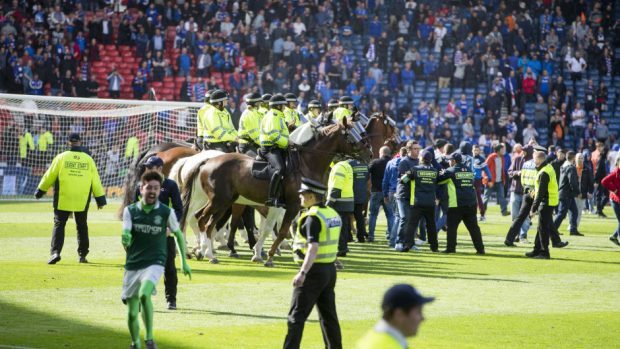Police chiefs have said there could have been deaths caused by crushing had more cops been deployed to stop the disgraceful pitch invasion at the Scottish Cup Final.
The stark claim came as Police Scotland rejected an official complaint about how it handled the match between Rangers and Hibernian that ended in mass violence in May,
Concerns have been raised about a lack of policing at the match and a failure to control the pitch invasion and subsequent disorder among fans.
And in a report commissioned by the SFA, it was suggested that there should be a reserve of police available to call on to deal with any trouble, such as that seen on May 21.
But in its response to the SFA report, Police Scotland said it would not have been feasible “to have hundreds, if not thousands of officers on standby” just in case a mass pitch invasion took place.
And the force added that any attempt to halt the pitch invasion could have ended in fans closest to the pitch being crushed by a surge of supporters pushing forward from behind them.
The unnamed author of the police response wrote: “I would point out that, in my opinion, had there been sufficient officers to deter those in the front rows from entering the pitch, any such action could have had a catastrophic effect had the many thousands of fans at the rear of the stadium surged forward.
“In such a scenario, a crushing situation would have been inevitable and could have resulted in serious injuries or fatalities.”
The author went on: “In the face of thousands of people determined to enter the playing surface, the police and stewards had little or no option into preventing this.
“I can confirm that there were significant numbers of officers deployed to police this event and this was in line with our experience of previous matches.”
The prospect of fans being crushed is likely to prompt comparisons between what could have happened at Hampden and the Hillsborough disaster, when 96 fans were killed by a human crush at the FA Cup semi-final between Liverpool and Nottingham Forest in April 1989.
By the beginning of August, 58 people had been arrested over the violence which followed the Scottish Cup Final, which Hibs won 3-2 to lift the trophy for the first time in 114 years.
The SFA report by Sheriff Principal Edward Bowen QC said both sets of fans were at fault in their behaviour.
He also suggested the government should consider making it a statutory offence to invade a football pitch.
Meanwhile, the Police Scotland response outlines why officers often arrest people after a match when there has been disorder, instead of during it.
The response says: “It is the duty of all police officers to prevent and detect crime and police officers are expected to intervene and arrest persons when it is practicable and safe to do so.
“As such, to make an arrest during a fixture with thousands of supporters within the ground is not always deemed appropriate… as that can lead to further public disorder…”
The response said the invasion came about due to the dramatic ending to the final, with the winning goal coming in during injury time.
The response’s author added: “The result of this was a pitch incursion by many thousands of Hibernian fans who were intent on celebrating their club’s victory, regardless of the safety rules and laws which are designed to prevent such incursions.
“It is also apparent that amongst the many thousands of fans determined to celebrate, there were a core of undesirable fans intent on ‘goading’ the Rangers fans and causing trouble.”
